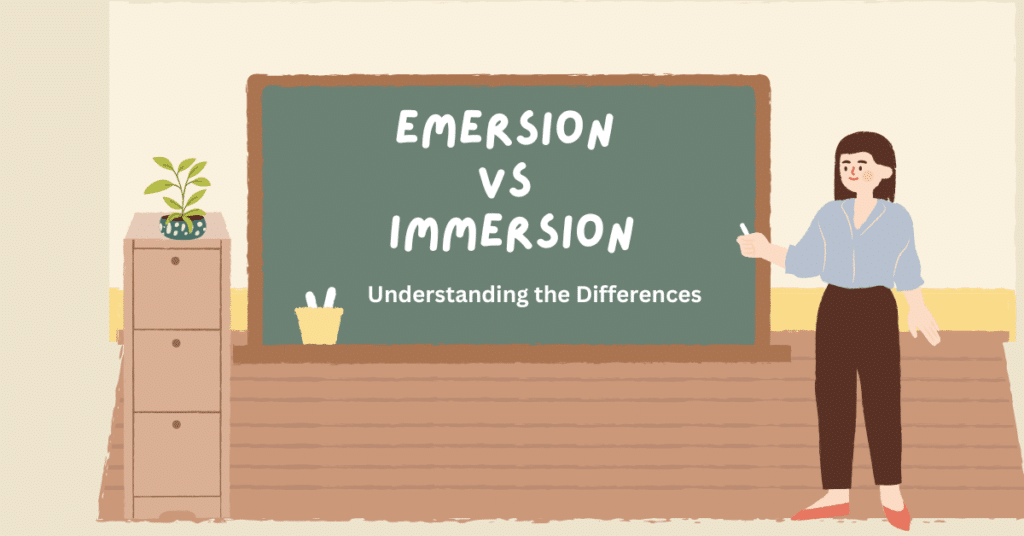Emersion and immersion are two concepts that often confuse people. Both words describe how we engage with our surroundings and experiences, but they mean different things. Understanding the difference can help us enhance our learning journey and improve personal development. In this article, we will explore the meanings, practical usage, and real-world applications of emersion and immersion.
Emersion vs. Immersion: Key Differences and Meanings
Definition: Emersion refers to the process of coming out or emerging from an experience, while immersion means being fully absorbed or enveloped in an experience.
Focus: Emersion focuses on reflection and understanding of past experiences, whereas immersion focuses on active engagement and participation in current experiences.
Mental State: Emersion involves a detached, contemplative mental state, while immersion involves an engaged, active mental state.
Learning Approach: Emersion is typically analytical and evaluative, whereas immersion is experiential and hands-on.
Psychological Effect: Emersion promotes mindfulness and introspection, while immersion fosters excitement, curiosity, and enthusiasm.
Example in Education: Emersion might involve reflecting on what was learned after a class, while immersion could involve participating in a language immersion program where learners practice speaking a language in real time.
Goal: The goal of emersion is to gain insights and lessons from past experiences, while the goal of immersion is to acquire skills through direct experience.
Connection to Environment: Emersion involves limited interaction with the surrounding context, whereas immersion fosters a deep connection with the environment and context.
Nature of Experience: Emersion is often passive and reflective, while immersion is active and participatory.
Temporal Aspect: Emersion typically occurs after an experience, while immersion happens during the experience.
Learning Retention: Emersion helps reinforce knowledge through reflection, whereas immersion enhances retention through active participation.
Cultural Understanding: Emersion allows for thoughtful consideration of different cultures, while immersion facilitates direct cultural experiences and understanding.
Contextual Application: Emersion is useful for evaluations and understanding after experiences, while immersion is effective for real-time learning and adaptation.
Personal Growth: Emersion supports self-awareness and personal insight, whereas immersion stimulates growth through exploration and active involvement.
Engagement Level: Emersion involves moderate engagement with experiences, while immersion entails total involvement in activities.
Learning Environment: Emersion is often structured and guided, while immersion is fluid and adaptive to the learning context.
Development of Skills: Emersion focuses on reflective skill assessment, whereas immersion emphasizes practical skill application.
Example Activities: Emersion can involve activities like journaling about past experiences, while immersion might include participating in simulations, workshops, or hands-on projects.
Long-term Impact: Emersion encourages sustained reflection on past experiences, while immersion leads to the immediate application of skills learned during the experience.
Overall Experience: Emersion involves analyzing and synthesizing past experiences, while immersion involves fully participating and engaging in current experiences.
Read more about Fairing or Faring? Understanding the Difference
Emersion vs. Immersion: Practical Usage Tips
| Tips | Emersion | Immersion |
| Goal Setting | Clearly define the purpose of stepping back or “emerging” from a situation to gain a fresh perspective and realign goals. | Set a focused objective for the immersive experience to ensure consistent engagement and deep learning. |
| Adjusting Environment | Find a quiet, separate space to remove distractions, allowing for a clearer reflection on recent experiences. | Create or find an environment rich with relevant elements (e.g., language or culture) to fully engage all senses. |
| Emotional Regulation | Use emersion as a way to detach and self-regulate emotions, especially after intense experiences. | Embrace all emotions during immersion to experience the situation fully and authentically. |
| Scheduling Breaks | Plan periodic emersion moments in long projects to avoid burnout and maintain clarity. | Limit distractions and allow for uninterrupted time blocks to maximize immersion benefits. |
| Balancing Perspectives | Emersion can help you step back and reassess from a broader viewpoint, helping with better decision-making. | Immerse fully in details to build a deep understanding, which can then be applied to larger tasks or goals. |
| Integrating Learning | Emersion helps consolidate knowledge by stepping back to review and organize information learned. | Engaging fully during immersion reinforces memory, especially for skills requiring practice and repetition. |
| Cognitive Reflection | Use emersion to critically analyze outcomes and experiences post-immersion. | Engage actively in real-time during immersion to deepen immediate cognitive connections. |
| Leveraging Sensory Inputs | Emersion focuses more on removing oneself from sensory overload to process information mentally. | Utilize sensory-rich elements during immersion to foster more engaging and memorable experiences. |
Using these terms correctly is essential for clear communication. When discussing educational strategies, you might say, “Language immersion programs are effective for language acquisition.” This sentence emphasizes the deep involvement in learning a new language. In contrast, if you reflect on your time in such a program, you could say, “After my immersion experience, I had a moment of emersion where I thought about what I learned.” This usage highlights the reflective aspect of emersion.
In many real-world applications, immersion is preferred for hands-on activities. For example, in training environments, immersive learning techniques engage participants fully. This approach often leads to enhanced understanding and retention of information. Emersion, meanwhile, can be helpful in post-experience evaluations, allowing individuals to assess what they gained from the immersive experience.
Emersion vs. Immersion
A simple comparison can clarify the differences between these two concepts. Emersion involves stepping back and reflecting on experiences, while immersion is about being fully engaged. These contrasting perspectives can be beneficial in various fields. For instance, educators can use immersion to captivate students’ interest and then allow emersion for deeper thinking.
Understanding these terms also helps in communication. When discussing personal growth, it is essential to specify whether you mean the reflection that follows an experience or the active participation in it. This clarity can enhance conversations about learning techniques and educational strategies.
Emersion vs. Immersion: 10 Key Differences
The differences between emersion and immersion can be summarized in several key aspects. Emersion is about emerging from a state, while immersion is about being enveloped in an experience. Another difference lies in their applications; emersion often focuses on reflection and learning from experiences, while immersion emphasizes engagement and active participation. Understanding these distinctions is vital for anyone involved in education or personal development.
These two concepts also differ in their psychological implications. Emersion encourages mindfulness and introspection, while immersion fosters excitement and curiosity. Recognizing these key differences allows us to choose the right approach depending on our goals, whether in a classroom, workplace, or personal life.
Emersion vs. Immersion: Key Points to Understand
Definition: Emersion refers to the act of emerging from a situation or experience, often involving reflection, while immersion denotes complete absorption or involvement in an experience.
Focus on Experience: Emersion emphasizes the insights gained from past experiences, whereas immersion centers on the active engagement and participation in the present experience.
Mental Engagement: Emersion involves a more analytical approach, where individuals reflect on what they have learned, while immersion engages participants in hands-on activities and direct involvement.
Temporal Nature: Emersion typically occurs after an experience as a means of processing it, while immersion happens in real-time during the experience, allowing for immediate learning and adaptation.
Psychological Impact: Emersion promotes mindfulness and self-awareness as individuals analyze their past, whereas immersion fosters excitement, curiosity, and deeper emotional connections through active participation.
Learning Styles: Emersion aligns more with analytical learning styles that benefit from evaluation and reflection, while immersion caters to experiential learning styles that thrive on interaction and practice.
Cultural Engagement: Emersion allows for thoughtful consideration of cultural contexts after exposure, while immersion provides firsthand experiences that enhance cultural understanding and empathy.
Skill Development: Emersion aids in consolidating knowledge through reflection, while immersion promotes the development of skills through practical application and real-world interactions.
Long-Term vs. Short-Term Learning: Emersion focuses on long-term retention and insights from experiences, while immersion leads to immediate learning outcomes and skill acquisition.
Applications: Emersion can be applied in scenarios such as writing reflective essays or engaging in discussions about past experiences, while immersion is seen in activities like language immersion programs or hands-on workshops that require active participation.
Adaptation vs. Involvement: Emersion involves adaptation to a new environment after emerging, often highlighting resilience. In contrast, immersion requires full involvement within an environment or activity, fostering intense focus.
Observation vs. Experience: Emersion often allows for observation from an external viewpoint, providing a broader perspective. Immersion, however, places individuals directly within the experience, making them active participants.
Sequential Learning: Emersion and immersion can complement each other in learning. Often, one immerses first to gather deep insights, followed by emersion to reflect on and apply what’s been learned.
Self-awareness: Emersion encourages self-reflection after stepping back, promoting clarity and understanding. Immersion cultivates self-awareness within the experience, as individuals respond and adapt in real-time.
Physical vs. Psychological Impact: Emersion frequently brings a physical change in state, like leaving water. Immersion, while sometimes physical, often affects psychological states, allowing people to delve into thoughts, cultures, or concepts at a deeper level.
Emersion vs. Immersion: 25 Examples of Emersion
Short-Term vs. Long-Term Engagement: Emersion often refers to brief exposure, stepping out for a moment before returning, whereas immersion implies a prolonged, dedicated involvement, leading to sustained learning or transformation.
Surface Interaction vs. Deep Dive: Emersion tends to involve surface-level interaction, gaining basic understanding without going too deep. Immersion requires diving into the core of an experience, absorbing all aspects to fully understand and appreciate the context.
Initial Awareness vs. Profound Insight: Emersion usually initiates awareness, allowing a person to glimpse new concepts or ideas. Immersion, on the other hand, brings about profound insights and allows for a deep comprehension that goes beyond initial awareness.
Flexibility vs. Stability: Emersion involves frequent transitions in and out of an environment, fostering adaptability. Immersion demands stability and a commitment to remain within the environment or activity, building endurance and resilience.
External Influence vs. Internal Absorption: Emersion often involves external influences, as individuals look outward while stepping into new surroundings. In immersion, the focus shifts inward as one fully absorbs and internalizes the environment or experience, leading to personal transformation.
Reflective Journals: Writing in a journal to analyze and reflect on personal experiences, feelings, and learning moments.
Post-Experience Discussions: Engaging in group discussions after a workshop or event to share insights and lessons learned.
Meditation and Mindfulness: Practicing meditation to become aware of thoughts and feelings, promoting self-reflection and personal growth.
Therapeutic Sessions: Participating in therapy sessions where individuals explore past experiences and emotions to gain deeper understanding.
Creative Writing: Composing poetry or stories that draw on personal experiences, allowing for exploration of emotions and lessons learned.
Artistic Expression: Creating artwork that reflects personal journeys, using the creative process to process emotions and experiences.
Self-Assessment: Completing self-assessment questionnaires to evaluate personal strengths and weaknesses, leading to personal development.
Goal Setting: Reflecting on past achievements and failures to set new, realistic goals for future personal and professional growth.
Life Review: Engaging in a life review process, where individuals reflect on significant life events and what they learned from them.
Book Clubs: Participating in book clubs where readers analyze and discuss themes and lessons from the book, drawing from their own experiences.
Travel Reflections: Writing travel blogs or memoirs that capture personal reflections and insights gained during journeys.
Peer Feedback: Receiving and providing constructive feedback in group settings, reflecting on how the input shapes perspectives and actions.
Vision Boards: Creating vision boards that combine images and words representing personal aspirations based on past experiences.
Online Forums: Engaging in online communities where individuals share stories and lessons learned from various life experiences.
Volunteer Reflection: After volunteering, writing reflections on the impact of the experience on personal values and community perspectives.
Retreats: Attending retreats that focus on self-reflection and personal development, allowing for quiet contemplation and insights.
Coaching Sessions: Working with a coach to explore past challenges and achievements, leading to greater self-awareness and goal clarity.
Life Coaching: Reflecting on significant life changes or transitions with a life coach to uncover underlying themes and motivations.
Family Discussions: Having family gatherings where members share stories from their past, learning from each other’s experiences.
Educational Reflections: After completing a course or training, writing a reflective piece on what was learned and how it can be applied moving forward.
25 Examples of Immersion
Cultural Home-Stay Programs: Staying with a local family in a foreign country allows individuals to live as locals do, embracing their daily routines, customs, and meals, creating a firsthand immersive cultural experience.
360-Degree Virtual Reality (VR) Training: Immersive VR simulations are used in fields like healthcare and aviation, where trainees experience realistic environments and scenarios that replicate real-world challenges, promoting hands-on learning without actual risk.
Intensive Language Boot Camps: Language immersion boot camps immerse learners in a setting where only the target language is spoken, fostering quick fluency by forcing participants to navigate every interaction—formal and informal—in the new language.
Volunteer Projects in Environmental Conservation: Immersing oneself in conservation work, such as reforesting an area or cleaning marine habitats, helps individuals understand environmental issues firsthand, allowing them to connect deeply with nature and environmental impact.
Artist Residency Programs: Artists participating in a residency fully immerse themselves in a creative environment, free from usual distractions, allowing them to focus entirely on developing new works, experimenting, and collaborating with other artists in a secluded setting.
Language Immersion Programs: Enrolling in programs where students are taught a new language through total exposure in real-life contexts, promoting faster acquisition.
Virtual Reality Experiences: Using virtual reality technology to create immersive environments for gaming, education, or training simulations.
Cultural Immersion Trips: Traveling to another country and living with local families to experience their culture, customs, and language firsthand.
Theatrical Productions: Participating in or attending immersive theater performances where the audience interacts with the actors and storyline.
Hands-On Workshops: Engaging in workshops that allow participants to actively create or produce something, such as cooking classes or art workshops.
Interactive Exhibits: Visiting museums with interactive displays that encourage visitors to engage directly with the exhibits for a deeper understanding.
Study Abroad Programs: Studying in a foreign country where students attend local universities, interact with native speakers, and fully engage with the culture.
Escape Rooms: Participating in escape room activities that require teamwork and problem-solving within a fully designed theme environment.
Gaming Worlds: Playing video games that offer expansive, immersive worlds where players can explore, interact, and engage with intricate storylines.
Science Labs: Conducting experiments in scientific laboratories where students actively participate in hands-on learning.
Culinary Classes: Taking part in cooking classes that not only teach recipes but also delve into the cultural significance of the cuisine.
Nature Retreats: Attending retreats in natural settings where participants engage deeply with the environment through activities like hiking and camping.
Music Festivals: Attending live music events where audiences are fully immersed in the performances and atmosphere, creating memorable experiences.
Historical Reenactments: Participating in or observing reenactments of historical events, allowing individuals to experience history as if they were part of it.
Mindfulness Workshops: Engaging in mindfulness and meditation sessions that encourage deep focus and presence, promoting a sense of calm and awareness.
Art Classes: Participating in art classes that encourage students to explore their creativity in a hands-on manner, experimenting with different techniques and mediums.
Cultural Festivals: Attending festivals that celebrate specific cultures, where attendees can engage with traditional music, dance, food, and customs.
Live Demonstrations: Watching live demonstrations at trade shows or fairs that allow attendees to see products in action and interact with experts.
Social Media Challenges: Participating in online challenges that encourage users to immerse themselves in specific activities or themes, sharing their experiences.
Thematic Parks: Visiting theme parks designed around specific themes or stories that create immersive experiences for visitors, engaging all their senses.
Read more about Perform or Preform: What’s the Difference?
What is the Main Difference Between Emersion and Immersion?
The main difference between emersion and immersion lies in their focus. Emersion emphasizes reflection and emergence, while immersion prioritizes deep engagement and total involvement. Both concepts are valuable in educational contexts, as they complement each other.
Understanding this difference can transform how we approach learning. For example, educators can incorporate both concepts into their teaching methods. Engaging students in immersive activities followed by reflective discussions allows for deeper understanding and retention of knowledge.
25 Key Distinctions Between Emersion and Immersion
| Distinctions Between Emersion and Immersion | Emersion | Immersion |
| 1. Engagement Style | Emersion promotes a temporary disengagement to process information. | Immersion promotes continuous, uninterrupted engagement for maximum involvement. |
| 2. Mental Focus | Focuses on analysis, reflection, and observation from a distance. | Emphasizes direct attention to the present moment, minimizing reflection during the experience. |
| 3. Sensory Input | Often minimizes sensory input to allow space for thought. | Increases sensory engagement, enhancing vividness of the experience. |
| 4. Impact on Creativity | Facilitates creative thinking through a detached perspective. | Boosts creativity by allowing full exploration without restrictions. |
| 5. Depth of Understanding | Encourages a broader view, connecting different perspectives. | Develops a detailed understanding of specific elements within an experience. |
| 6. Energy Expenditure | Requires less immediate energy due to reflective nature. | High energy, as immersion demands intense focus and engagement. |
| 7. Information Processing | Processes information in chunks, often after the experience. | Processes information in real time, adapting instantly. |
| 8. Use in Problem-Solving | Effective for generating insights post-experience. | Useful for real-time problem-solving and adaptability. |
| 9. Connection with Environment | Creates a sense of distance from the environment. | Builds a strong connection to the environment, feeling “part of” it. |
| 10. Physical Presence | Can involve being physically removed or mentally detached. | Requires physical presence and active participation. |
| 11. Learning Style Preference | Benefits learners who prefer contemplation and analysis. | Benefits learners who prefer hands-on, experiential learning. |
| 12. Emotional Regulation | Provides time to manage emotions without pressure. | Encourages immediate emotional engagement, beneficial in high-energy situations. |
| 13. Psychological Effects | Encourages introspection and understanding of personal responses. | Promotes outward-focused awareness and sensory stimulation. |
| 14. Long-term Retention | Builds long-term understanding through reflective practice. | Creates memorable moments through immersive, impactful events. |
| 15. Personal Comfort | Often used in comfortable, familiar environments. | Requires stepping out of comfort zones into new settings. |
| 16. Time Perspective | Focuses on long-term reflection. | Focuses on immediate experience and short-term engagement. |
| 17. Ideal Settings | Quiet, contemplative spaces conducive to thought. | Dynamic, stimulating environments that encourage exploration. |
| 18. Cognitive Style | Supports abstract and big-picture thinking. | Fosters concrete, detail-oriented thinking. |
| 19. Impact on Personal Growth | Builds self-awareness through reflective distance. | Builds confidence and adaptability through active participation. |
| 20. Role in Skill Mastery | Helps internalize skills and knowledge through observation. | Helps build proficiency through real-time application and practice. |
| 21. Typical Personality Fit | Appeals to introspective, observant individuals. | Appeals to adventurous, experiential individuals. |
| 22. Stimulus Type | Low-stimulation for focused thought. | High-stimulation for active learning. |
| 23. State of Mind | Mind is in a contemplative, observational mode. | Mind is fully engaged and responsive. |
| 24. Usefulness in Communication | Effective for assessing and discussing experiences. | Useful for storytelling and conveying vivid experiences. |
| 25. Influence on Decision-Making | Helps refine choices through hindsight. | Supports immediate decision-making through situational awareness. |
Recognizing the key distinctions between emersion and immersion can enhance our understanding of these concepts. Emersion often involves a sense of separation, allowing individuals to step back and reflect. Immersion, however, creates a feeling of being surrounded by an experience, promoting total engagement.
These distinctions impact how we learn and grow. Emersion can lead to increased self-awareness and mindfulness, while immersion fosters curiosity and exploration. By recognizing and applying these differences, we can enhance our personal development and learning strategies.
Read more about Opened vs Openned: Correct Spelling & Usage Examples
30 Points about Emersion and Immersion
Emersion
- Definition: Emersion refers to the process of coming into view or rising out of a submerged state.
- Natural Phenomenon: It often describes physical processes, such as plants emerging from soil or animals surfacing from water.
- Symbol of Growth: Emersion is associated with personal development and the unfolding of potential.
- Psychological Aspect: It can signify the emergence of new ideas or perspectives in an individual’s mind.
- Environmental Awareness: Emersion emphasizes the importance of becoming aware of one’s surroundings and the changes in nature.
- Life Experiences: It represents moments in life when individuals rise above challenges and discover new strengths.
- Transition States: Emersion can denote the transition from one state of being to another, such as from uncertainty to clarity.
- Cognitive Engagement: The act of emersion can stimulate cognitive engagement as individuals reflect on their experiences.
- Creativity: Emersion often leads to bursts of creativity, as new ideas come to light.
- Personal Growth: Individuals may experience emersion when they break free from limiting beliefs and explore new possibilities.
Immersion
- Definition: Immersion involves being deeply engaged or absorbed in an experience or environment.
- Learning Techniques: It is a key concept in education, especially in language learning, where students practice in real-life contexts.
- Total Involvement: Immersion requires total involvement in an activity, leading to a more profound understanding.
- Cultural Connections: It fosters connections to different cultures by allowing individuals to experience them firsthand.
- Hands-On Activities: Immersion often includes hands-on activities that encourage active participation.
- Enhanced Understanding: Engaging fully in an experience can lead to an enhanced understanding of the subject matter.
- Virtual Reality: Immersion is often facilitated through technologies like virtual reality, creating lifelike experiences.
- Deep Learning: It promotes deep learning by engaging multiple senses and cognitive pathways.
- Mindfulness Practices: Immersion in mindfulness practices encourages awareness of the present moment.
- Transformative Experience: Immersion can be transformative, changing how individuals perceive and interact with the world.
Comparisons and Intersections
- Differences: While emersion emphasizes emergence and growth, immersion focuses on deep engagement and absorption.
- Applications in Education: Both concepts are applied in educational strategies to enhance learning outcomes.
- Psychological Implications: Emersion often reflects psychological growth, while immersion can lead to cognitive overload if not balanced.
- Environmental Influence: Both processes are influenced by environmental factors, shaping how individuals experience growth and engagement.
- Cultural Significance: Immersion can lead to cultural appreciation, while emersion can highlight the importance of personal connections to culture.
- Personal Development: Both concepts contribute to personal development but approach it from different angles—emersion from emergence and immersion from engagement.
- Engagement Techniques: Emersion may involve reflective practices, while immersion requires interactive methods for maximum impact.
- Real-World Applications: Emersion can apply to personal experiences, whereas immersion is often linked to structured environments like classrooms or workshops.
- Learning Outcomes: Immersion tends to yield immediate learning outcomes, while emersion may offer long-term personal growth.
- Community Building: Both emersion and immersion can foster community, encouraging shared experiences and collective learning.
20 Examples for Emersion
Many examples illustrate the power of emersion. After a long trip, travelers often reflect on their experiences, leading to greater appreciation of different cultures. In the workplace, employees might review their performance after a project, assessing strengths and areas for improvement. Writers frequently emerse themselves in their drafts, stepping away to gain fresh insights before editing.
During personal development workshops, participants often take time to reflect on their insights and growth. These moments of emersion create opportunities for deeper understanding and engagement with the learning process. Each example highlights how emersion can enhance our ability to learn and grow.
Immersion
Immersion is vital for engaging with new experiences fully. When individuals immerse themselves in an activity, they become deeply involved and connected to what they are doing. This connection leads to enhanced understanding and a richer learning experience.
In education, immersion techniques help students grasp complex concepts. By engaging with subjects actively, students retain information better and develop a passion for learning. Immersion fosters an environment where curiosity thrives, encouraging exploration and discovery.
Read more about 100 Cool xbox names Gamertag Ideas for 2024
Immersive Learning: Diving Deep into the World of Knowledge
Immersive learning transforms the way we acquire knowledge. By fully engaging with material, learners absorb information more effectively. This approach allows for deep learning experiences that go beyond traditional methods. Immersive learning can occur through simulations, hands-on activities, and interactive lessons.
The key to successful immersive learning lies in creating an engaging environment. When learners feel connected and involved, they are more likely to retain information and apply it in real-world situations. Immersive experiences can unlock new worlds and foster cultural connections, broadening our understanding of various topics.
Embracing Novelty and Curiosity: Unleashing the Power of Immersive Learning
Embracing novelty and curiosity is essential for effective immersive learning. When individuals approach new experiences with an open mind, they unlock opportunities for deeper understanding. Curiosity drives engagement and encourages exploration of unfamiliar topics.
Immersive learning techniques, such as project-based learning, foster curiosity. By working on real-world projects, learners explore new ideas and gain insights that enhance their knowledge. This exploration promotes a sense of ownership over their learning journey, leading to a more meaningful and memorable experience.
Enhancing Immersion: The Power of Active Observation
Active observation is a crucial component of immersion. When individuals engage in active observation, they pay close attention to their surroundings and experiences. This attention to detail enhances understanding and retention of information.
In educational settings, active observation allows students to absorb information more effectively. By encouraging students to notice subtle details, educators can create richer learning experiences. This practice enhances cognitive engagement and fosters a deeper
connection to the material being studied.
FAQs
Is it immersion or immersion?
The correct term is “immersion,” which refers to the state of being deeply engaged or absorbed in an experience. “Emersion” describes the process of emerging from a submerged state.
What is emersion?
Emersion is the act of coming into view or rising out of a submerged state. It often symbolizes growth, change, or the emergence of new ideas.
What is immersion emersion in psychology?
In psychology, “immersion” refers to deeply engaging in experiences for enhanced learning or emotional connection, while “emersion” indicates the emergence of new thoughts or insights during personal growth.
What is emersion in marine science?
In marine science, emersion describes the exposure of marine organisms to air as tides recede. This process affects their survival and behavior, as they adapt to changes in their environment.
How do emersion and immersion relate to personal development?
Emersion and immersion both contribute to personal development by fostering growth through new experiences. Emersion signifies emerging insights, while immersion promotes deep engagement in learning and self-discovery.
Conclusion
In conclusion, understanding the differences between emersion and immersion is essential for enhancing our learning experiences. Emersion encourages reflection and personal growth, while immersion fosters deep engagement and active participation. By recognizing the unique qualities of each concept, we can apply them effectively in various contexts.
Both emersion and immersion play vital roles in our learning journey. By combining these approaches, we can create transformative experiences that promote deeper understanding and personal development. Embracing both concepts will enhance our curiosity, engagement, and cultural connections, leading to a richer and more fulfilling learning experience.

Luna Jasper is an experienced blogger with a passion for language and grammar. At **Collective Nouns World**, she shares her expertise in exploring the fascinating world of collective nouns, making learning both engaging and fun. With years of writing and research under her belt, Luna’s insightful articles help readers understand and appreciate the English language.







